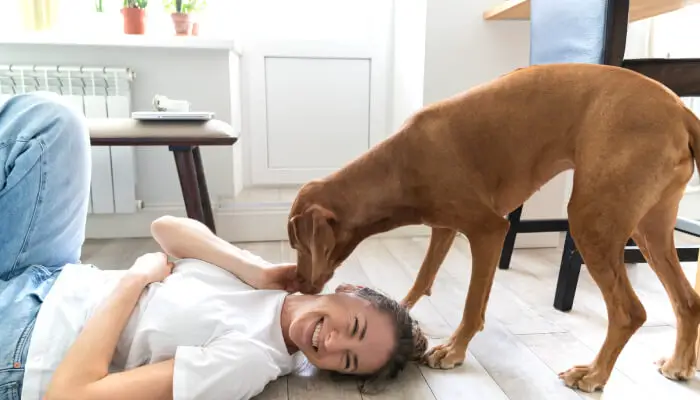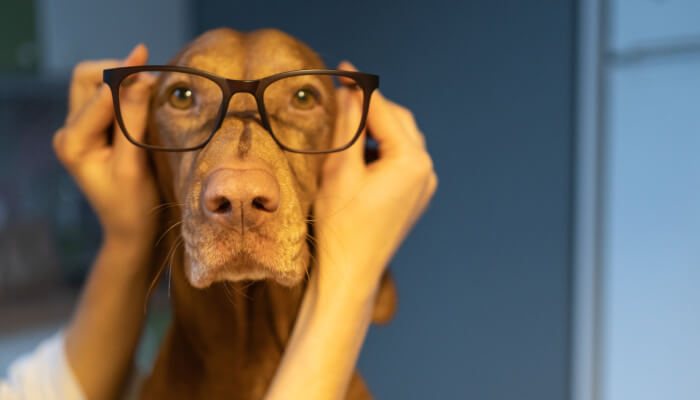Vizsla is a beautiful dog breed that comes in many different colors. Unfortunately, two Vizslas have skin problems: the Vizsla with dry skin and the Vizsla with oily skin. Both types of Vizslas need care differently, so it’s important to know how to tell which type you have.
Dry skin Vizsla will require more bathing than an oily Vizsla because their coat has less oil content and therefore dries out easily, whereas an oily Vizsla only needs a bath or shower every few months when they get filthy. An owner should also use a moisturizing shampoo on their dry-skinned Vizsla once per week to keep the skin healthy and avoid skin problems.
In Vizslas with dry skin, the cause is often genetic. Some Vizsla breeds have a propensity for various types of skin problems. So, it is better not to breed those breeds because it can lead to health complications in puppies.
An owner caring for a Vizsla with an oleaginous coat needs to usually do a bath or shower every few months to give their Vizsla a deep clean, and then only use a moisturizing shampoo once per week.
Is Vizsla Prone To Skin Problems?
The Vizsla breed tends to develop skin problems. Vizslas are also sensitive to fleas, ticks, and other parasites that can cause allergic reactions in some dogs. One of the most common Vizsla skin problems is Demodectic mange. This infection usually develops between six months and three years old when the Vizsla experiences a hormonal change in their system. Another common Vizsla skin problem is Pemphigus foliaceous, an autoimmune disease that causes crusty lesions on the Vizslas’ body and face.
Furthermore, the skin coat of Vizsla is comparatively shorter than other dog breeds, which makes Vizsla more prone to sunburn. Vizslas are also prone to such diseases as cutaneous leishmaniasis and distemper if you fail to vaccinate them.
Common Skin Problems In Vizsla
Vizslas are prone to skin problems if you fail to give them a proper diet and grooming. Vizsla coats can have dry, itchy patches that will develop into constant scratching, leading to various other health issues like infections or ear mites.
However, the common skin problems in Vizsla are:
Allergies
Vizsla allergies will usually appear on the Vizslas’ paws or ear tips due to constant contact with something that Vizsla is allergic to. This often happens in Vizslas, who are constantly licking their feet or scratching their ears. In addition, Vizsla allergies often lead to other skin problems like hot spots, hair loss, and redness.
Vizslas with allergy-prone skin need to avoid contact with any substances that Vizsla may be allergic to or cause irritation in the dog’s system (e.g., flea collars, deodorant, fabric softener). In addition, you should give a bath and groom your Vizsla weekly if it has allergy-prone skin.
Atopy In Vizsla
The Vizsla is a susceptible breed with an atopic tendency. They suffer from chronic skin conditions such as allergies due to the environment, food, or contact stimuli. Dogs who are allergic to pollen and spores of plants can have respiratory problems if they live in areas where these allergens exist every day (a Vizsla owner from the northeastern U.S. can attest to this). Vizsla, with allergies, will have skin and ear problems.
Pruritus In Vizsla
Pruritus is a common cause of itching in Vizslas. It can be due to dermatitis, allergies, or other causes such as dietary deficiencies and parasites.
The most commonly found parasites are fleas and ticks. Therefore, you should check your Vizsla for parasitic infection before the diagnosis of pruritus. It is necessary because pruritus and allergic reactions to parasites have different treatments. In addition, you should also eliminate any of these external factors before treatment if present.
Pruritus can occur on any body part but usually involves the head, neck, legs, and abdomen (the site of an insect bite could lead you right back to its source).
Crusty Skin (Flaky)
Crusty skin (Flaky) is a Vizsla skin problem where the dog’s skin will produce excessive amounts of dry, crusty flakes. The Vizslas coat may also be dull and rough to touch. This Vizsla skin problem can either be due to infection or noninfectious causes such as allergies, endocrine problems, or malnutrition. Sometimes crusty Vizslas are just suffering from seasonal allergies that appear in different forms throughout life cycle stages. For example, if your Vizsla has “atopy,” then they might have some itching disorder. And it is often related to food sensitivities when there are environmental allergens present- like pollen, dust mites, etc.
Pyoderma – Acute Plaque Pyoderma
Pyoderma describes red or pink lesions with a moist, crusted surface. A Vizsla’s pyoderma is acute when the lesion has been present for less than one week and chronic if it has been there for more than six weeks. Acute plaque pyodermas occur due to an infection from bacteria that live on the skin (Staphylococcus sp.). Chronic plaque pyodermas may be due to allergies, hormonal changes in females going into heat, pregnant female Vizslas shedding their dead puppies’ hair coats at about 30 days of gestation, mites such as scabies; flea infestation, or food allergy.
Hair Loss Or Alopecia
Alopecia is hair loss in Vizslas. This condition may be due to several causes, including hormonal imbalances and genetic conditions common in some breeds. It also occurs by illnesses such as mange or other skin problems like seborrhea dermatitis (scaly dry dandruff).
The Vizsla’s coat is the most important feature of their appearance. Without it, they will have difficulty attracting potential owners. Therefore, you should not ignore the hair loss in your Vizsla. Instead, try investigating thoroughly to find the root cause so that you can treat them.
Seborrhea Dermatitis (Scaly Dry Dandruff)
Seborrhea dermatitis is a type of skin disease in Vizsla that manifests with scaly, dry dandruff. It usually occurs as patches on the Vizsla’s body and can be present around their eyes, ears, and inner thighs/groin area. This condition causes itching and redness among Vizslas. The Vizsla may also experience hair loss or alopecia because this condition makes it difficult for them to groom themselves properly. Symptoms include blackheads and increased production of sebum (cholesterol).
The cause of dermatitis is an abnormal growth of bacteria at the top layer of your Vizsla’s outermost protective skin cells. Those cells are stratum corneum that induce the production of more sebum (cholesterol).
Mange – Demodectic, Sarcoptic
Mange is an infection that occurs due to tiny mites on Vizsla’s skin and hair follicles. Vizslas are highly susceptible to mange and can develop it as early as six weeks old. Other symptoms include inflammation, crusting, scaling, hair loss, or alopecia around the neck and head region (particularly on the back of ears), redness in patches around the eye area, ear infections, scabs near genitals.
The itching must also be present for there to be an accurate diagnosis with demodectic mange. The most common type of sarcoptic mange in Vizsla dogs is “walking dandruff,” which typically has no itchiness but moves quickly from one region to another over time.
Causes Of Skin Problems In Vizsla
Depending on the various skin problems of Vizsla, the cause of those problems also varies. Moreover, some of the common causes of skin problems are:
Environment And Stress
Environmental factors such as chemicals, soaps, or detergents can have a drying effect on Vizslas’ skin, leading to problems like dryness and scaling. In some cases, allergies may be the underlying cause of these conditions.
Vizslas are also prone to skin problems due to excessive licking or chewing, which can signify stress. Vizsla’s with such behaviors needs regular health examination from the veterinarian for underlying causes and treatment accordingly.
Genetic Predisposition
Genetics can be another cause of Vizsla skin problems. Vizslas are susceptible to atopy, a disease where an overactive immune system can be vulnerable to environmental allergens such as dust mites or pollen.
Further, Vizsla dogs have a short hair coat that can trap dirt and bacteria, which is difficult to clean. Vizslas also don’t sweat very much, so they need some help in the hot summer months.
Underlying Disease Can Skin Problems In Vizsla
Vizslas are prone to several health issues that directly or indirectly cause skin problems. Vizslas suffer from skin diseases like atopy and seborrhea dermatitis (scaly dry dandruff), which are not true skin conditions but rather a manifestation of underlying disease. Vizsla’s may also experience hair loss or alopecia and common types of parasitic infections that cause itching or lesions on the dog’s body, such as fleas and ticks.
Parasitic Infection
Being a hunting dog, Vizslas loves to play, run, and retrieve things. So, they get more exposure to fleas, ticks, infections by yeast, and bacterial organisms. Thus, Vizsla has two natural enemies in its environment – fleas and ticks, which lead to different dermatitis viz: erythema multiforme (EM), pyoderma; some even see hair loss or alopecia along with seborrhea dermatitis-scaly dry dandruff plus mange demodectic/ sarcoptic among others.
Further, Vizslas are also prone to parasitic infections like hookworms, roundworms, and tapeworms that can deteriorate their skin and health.
Treatment Of Skin Problems In Vizsla
Skin problems are dangerous for Vizsla. And if you leave them without treatment, it might result in fatal consequences. Thus, it would help if you treated them in time.
So, some of the treatment methods for skin problems of Vizsla are;
- Antibiotic and antifungal medicine will help Vizslas get rid of skin diseases such as “pyoderma.”
- Oatmeal bath: Vizslas with skin problems may often suffer from itchiness. A good way to soothe them is through oatmeal baths.
- Treating dryness or flaking of the Vizsla’s skin: Vizslas are prone to this condition, and you need a special moisturizer for Vizslas that will help prevent their skins from drying out too much.
- Oil massage: With this, you can make your Vizsla feel better by making it relax. It also helps to calm down any itchiness they might be experiencing due to allergies or other reasons such as flea bites, etc…
- Frequent grooming: This is especially important if your Vizsla has “atopy.” Grooming makes sure that Vizsla’s skin is free from any irritants.
- Dietary supplements: the Vizsla is prone to various allergies that you can treat with dietary changes. Thus, it would be best if you gave them a diet for their skin condition.
- Bathing Vizslas in lukewarm water mixed with vinegar or bicarbonate soda may also offer relief from itching caused by dryness.
However, if the skin problems seem to get worse, you should consult the Vet.
Preventive Measures To Avoid Skin Problems In Vizsla
When Your Vizsla has skin problems, it loses its beauty. And it takes a lot of time to resolve all the skin issues and return to the previous state. Thus, preventing skin problems is the best.
However, few preventive measures to avoid skin problems in Vizsla are:
Healthy Diet Prevents Skin Problems In Vizsla
Vizslas are not picky eaters, but you should make sure they have a high-quality diet. It is easy to find some dog food brands that offer holistic foods and raw meat for your Vizsla.
Further, food rich in omega-acids promotes shiny, silky, and smooth skin coats and protects the skin. So, emphasize more on such foods. Besides, adding few drops of coconut oil to your Vizsla’s daily meal can also improve its skin.
Grooming Your Vizsla Regularly Prevents Skin Problems
Brushing the hair of Vizslas regularly removes debris from them. You can also trim their nails if needed or clean their ears as this might cause skin problems in Vizsla.
Moreover, if you are new to grooming, you can take help from professional groomers. Further, as professionals are best in their job, take your Vizsla for professional grooming once in a while.
Give Regular Baths
Vizslas can take baths in warm water with a good dog shampoo. This will clean their skin and remove oil, dirt, and debris from the outer layer of Vizsla’s coat to avoid Vizsla skin problems.
Always make sure you use dog-based products for bathing, and don’t forget to condition your Vizslas hair after shampooing. Also, ensure that your Vizslas is completely dry before leaving him to play.
Monitoring The Heat And Humidity
When it’s hot outside, wearing light clothing will help prevent overheating. If it is humid outside, then cool down with water often to avoid Vizsla skin problems.
A humid environment drains all the essential oils from Vizsla’s skin coat easily because the coat is thin and short. So, Vizslas cannot cool themselves off efficiently in humid environments. And this results in a dry and flaky skin coat of your dog.
Keep Vizslas Out Of The Sun To Prevent Skin Problems
It is important to keep Vizslas out of the sun for long periods as it can cause their skin to dry. You should never leave Vizsla in the sun or under the heat of a lamp for more than 20 minutes. This will cause Vizsla skin problems and make them feel uncomfortable. However, if they have a fever, then you should take them in the sunlight.
Skin Care Products For Vizsla To Prevent Problems
You will need some special products for Vizsla with sensitive, allergy-prone, or harsh weather conditions. These include oils such as coconut oil, jojoba oil, dog shampoo containing oatmeal flakes or quinoa grains, moisturizing cream made with aloe vera gel from plants, and essential oils like oils lavender oil, anti-fungal cream containing tea tree.
Conclusion
In conclusion, Vizsla is prone to skin problems, but Vizsla owners can avoid them with the proper care. It would be best if you cleaned Vizslas weekly or bi-weekly, depending on their breed and hair type. In addition, they need to have an appropriate diet for a dog and plenty of exercises outdoors to stay healthy and happy.
I hope this post gave you some insight into Vizslas and their skin problems. If you want to know more, please leave a comment. Also, don’t hesitate to share your thoughts and suggestions.



